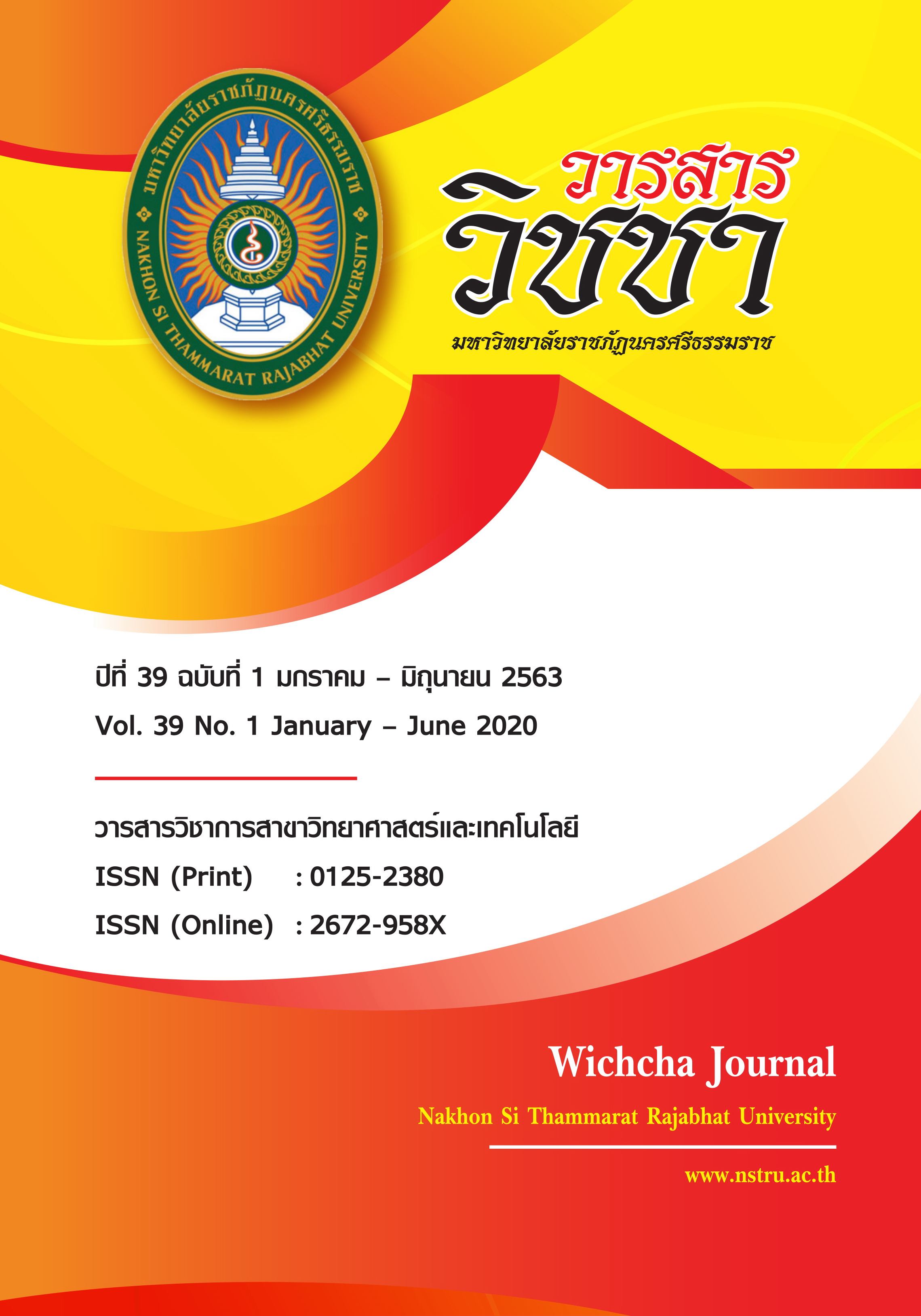Diversity and Distribution of Juvenile Fishes in the Khuan Khee Sean Peat Swamp, Phatthalung Province ความหลากหลายและการกระจายของลูกปลาในพรุควนขี้เสียน จังหวัดพัทลุง
Main Article Content
Abstract
Diversity and distribution of juvenile fishes in the Khuan Khee Sean peat swamp, Phatthalung province were studied. The samplings were conducted bi-monthly between August 2015 and June 2016 in 6 sampling stations around the peat swamp area by using the push net (1x1x1 m3) with the mesh size of 1 mm. The objectives were to study the characteristics of Khuan Khee Sean peat swamp, to assess the diversity, abundance and distribution of juvenile fish, to study the juvenile fish community structures, and to assess the relationship between water quality parameters, species, and juvenile fish abundances. Thirty juvenile fish species in 14 families were collected with the highest diversity of species from Family Cyprinidae (12 species). Only Trichopsis vittata was found in every station and every survey round. The average fishery products were 587 fishes/100 m2, in which Aplocheilus panchax, Boraras urophthalmoides and Trichopsis vittata were the main elements of the structure as the three most abundance species. Peaks of diversity index were observed in the station at the upper part of the swamp and in the December 2015. The ranked species abundance curves indicated the domination of few species contributed over 50% of cumulative dominance in the area. The assemblage patterns of juvenile fishes in the Khuan Khee Sean peat swamp can be categorized into 4 groups related to the temporal approach. However, there was no clear relationships with the water quality parameters.
Article Details
เนื้อหาและข้อมูลในบทความที่ลงตีพิมพ์ในวารสารวิชชา มหาวิทยาลัยราชภัฏนครศรีธรรมราช ถือเป็นข้อคิดเห็นและความรับผิดชอบของผู้เขียนบทความโดยตรง ซึ่งกองบรรณาธิการวารสารไม่จำเป็นต้องเห็นด้วยหรือร่วมรับผิดชอบใด ๆ
บทความ ข้อมูล เนื้อหา รูปภาพ ฯลฯ ที่ได้รับการตีพิมพ์ในวารสารวิชชา มหาวิทยาลัยราชภัฏนครศรีธรรมราช ถือเป็นลิขสิทธ์ของวารสารวิชชา มหาวิทยาลัยราชภัฏนครศรีธรรมราช หากบุคคลหรือหน่วยงานใดต้องการนำข้อมูลทั้งหมดหรือส่วนหนึ่งส่วนใดไปเผยแพร่ต่อหรือเพื่อการกระทำการใด ๆ จะต้องได้รับอนุญาตเป็นลายลักษณ์อักษรจากวารสารวิชชา มหาวิทยาลัยราชภัฏนครศรีธรรมราชก่อนเท่านั้น
The content and information in the article published in Wichcha journal Nakhon Si Thammarat Rajabhat University, It is the opinion and responsibility of the author of the article. The editorial journals do not need to agree. Or share any responsibility.
References
Ahmad, M.F. and Samat, A. (2015). Species composition and abundance of peat swamp fishes in selected areas of Selangor, Malaysia. Applied Biology, 44(1), 139-145.
APHA. (1989). Standard methods for the examination of water and wastewater. (17th ed). Washington D.C.: American Public Health Association.
Cortizas, A and Chesworth, W. (2006). Peatlands: evolution and records of environmental and climate changes. Elsevier, 9(1), 145-172.
Hsieh, H. and Lo, W. (2019). Mesoscale distribution and assemblage structure of fish larvae in the Kuroshio waters off eastern Taiwan. Marine Biodiversity, 49, 1971-1986.
Jutagate, T., Rattanachai, A., Udduang, S., Lek-Ang, S. and Lek, S. (2016). Fish larvae in a reservoir of the lower Mekong basin: their abundances, relationships to environmental variables and assemblage patterns. Indian Journal of Fisheries, 63(3), 11-23.
Munk, P., Bjørnsen, P.K., Boonruang, P., Fryd, M., Hansen, P.J., Janekarn, V., Limtrakulvong, V., Nielsen, T.G., Hansen, O.S., Satapoomin, S., Sawangarreruks, S., Thomsen, H.A., and Østergaar, J.B. (2004). Assemblages of fish larvae and mesozooplankton across the continental shelf and shelf slope of the Andaman Sea (NE Indian Ocean). Marine Ecology Progress Series, 274, 87-97.
Nagano, T., Osawa, K., Ishida, T., Sakai, K., Vijarnsorn, P., Jongskul, A., Phetsuk, S., Waijaroen, S., Yamanoshita, T., Norisada, M. and Kojima, K. (2013). Subsidence and soil CO2 efflux in tropical peatland in southern Thailand under various water table and management conditions. Mires and Peat, 11(06), 1-20.
Nakhon Si Thammarat Inland Fisheries Research and Devekopment Center. (2018). Biological diversity and fishery resources of the Phru Kuan Kreng Wetland. Retrieved 14 January 2020, From: https://www.fisheries.go.th/sf-nakhonsri/images/research/p_r.pdf.
Ng, P.K.L. and Tan, H.H. (1997). Freshwater fishes of southeast Asia: potential for the aquarium fish trade and conservation issues. Aquarium Science and Conservation, 1(2), 79-90.
Oksanen, J., Blanchet, F.G., Friendly, M., Kindt, R., Legendre, P., McGlinn, D., Minchin, P.R., O'Hara, R. B., Simpson, G.L., Solymos, P., Stevens, M.H.H., Szoecs, E. and Wagner, H. (2019). Vegan: community ecology package. r package version 2.5-5. Retrieved 4 January 2020, From: https://CRAN.R-project.org/package=vegan.
Page, S.E, Rieley, J.O. and Wüst, R. (2006). Lowland tropical peatlands of southeast Asia. In Martini, I.P., Martínez Cortizas, A., and Chesworth, W., (Eds.). Peatlands: evolution and records of environmental and climate changes. Developments in Earth Surface Processes, pp. 145-172.Netherlands: Elsevier Science.
Quist, M.C., Pember, K.R., Guy, C.S. and Stephen, J.L. (2004). Variation in larval fish communities: implications for management and sampling designs in reservoir systems. Fisheries Management and Ecology, 11, 107-116.
R Core Team. (2019). R: a language and environment for statistical computing. R foundation for statistical computing. Retrieved 4 January 2020, From: https://www.R-project.org/.
Schofield, P.J and Schulte, J.M. (2016). Small but tough: what can ecophysiology of croaking gourami, Trichopsis vittata (Cuvier, 1831) tell us about invasiveness of non-native fishes in Florida?. NeoBiota, 28, 51-65.
Sichum, S., Tantichodok, P. and Jutagate, T. (2013). Diversity and assemblage patterns of juvenile and small sized fishes in the nearshore habitats of the gulf of Thailand. The Raffles Bulletin of Zoology, 61(2), 795-809.
Suksri, S. and Boonsoong, B. (2018). The post-larval and juvenile fish assemblage in the Sukhothai floodplain, Thailand. Journal of Oceanology and Limnology, 36(3), 1013-1024.
Sule, H.A., Ismail, A. and Amal, M.N.A. (2016). A review of the ichthyofauna of Malaysian peat swamp forest. Pertanika Journal of Tropical Agricultural Science, 39(4), 421-458.
Vidthayanon, C., (2002). Peat swamp fishes of Thailand. Bangkok: Office of Environmental Policy and Planning.
Yule, C.M. (2010). Loss of biodiversity and ecosystem functioning in Indo-Malayan peat swamp forests. Biodiversity Conservation, 19, 393-409.


